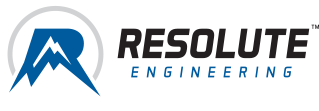
Grab a pencil and gazetteer, or even a USDA quad map of the area of interest for your pipeline, maybe a spreadsheet to capture the elevation data. These tools, along with a savvy local knowledge of the route, were stock in trade for route selection and site development not that long ago. Google Earth and handheld GPS tools have certainly added elements of precision and profile feedback that greatly increase the speed at which route selection and refinement occur. Now consider the permitting, landowner considerations, foreign pipeline/fiber/utility crossings, terrain changes, sideslope, geology, waterways, T&E species considerations (and more) and the route development to get from Objective A to B has become a quite complex and iterative process.
Resolute uses a proprietary routing tool to configure the project Details, such as corridor widths, mapping projection and easement widths; Objectives that define a route's start and end points; Constraints, such as geologic avoidance, colocation desires, environmental concerns, and exclusion areas; Route Scenarios to compare; and Suitability maps to review the pros and cons and each route selected.
System Databases linked to dozens of cloud-based resources feed the algorithms that optimize the route scenarios. Once the basic Objectives are understood (point A to B), we get to work setting a Constraint network, utilizing slider bars on System Data ranging from “Prefer” to “Exclude”, that is appropriate for the region and client preference. We can offer infinite constraint refinement choices to check “what if” scenarios and can generate alternate routes based on the new constraints.
Examples of constraints include Critical habitat polygons, EPA 303 C&D waterbodies, Mines, Geotechnical hazards, Historic sites, Parks, Residential areas, Wetlands, Trust lands, PHMSA HPA, Infrastructures (Airports, Cemeteries, First Nations Sites, Water wells, Water sources, Sewage treatment, RR bridges, Refineries, etc.).
 Each Route scenario pairs a Constraint network and co-locating route setting to generate a color coded suitability map that demonstrates the optimal route for the Objectives. Two or three, even four routes or more can be compared side-by-side in this way.
Each Route scenario pairs a Constraint network and co-locating route setting to generate a color coded suitability map that demonstrates the optimal route for the Objectives. Two or three, even four routes or more can be compared side-by-side in this way.
Depending on the length of the route (or size of non-linear Facility footprint), the algorithms run behind the scenes to generate the optimal routes. Coupled with Resolute Pipeline Estimate Tool, we can generate TIC estimates for any and all the route options to make cost and schedule comparisons side-by-side.
CLICK HERE to view a pdf demonstration of what you can expect to receive from the Route/Site Developer Tool, or click on the image in the menu to the right to view this demonstration.

